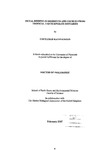Metal binding in sediments and cockles from tropical and temperate estuaries
| dc.contributor.author | Kavinseksan, Chutamad | |
| dc.contributor.other | Faculty of Science and Engineering | en_US |
| dc.date.accessioned | 2011-09-23T14:18:22Z | |
| dc.date.available | 2011-09-23T14:18:22Z | |
| dc.date.issued | 2007 | |
| dc.identifier | Not available | en_US |
| dc.identifier.uri | http://hdl.handle.net/10026.1/641 | |
| dc.description | Merged with duplicate record 10026.1/2277 on 27.02.2017 by CS (TIS) | |
| dc.description | Merged with duplicate record 10026.1/2277 Submitted by Collection Services (collectionservices@plymouth.ac.uk) on 2013-10-22T10:12:58Z No. of bitstreams: 1 CHUTAMAD KAVINSEKSAN.PDF: 13702377 bytes, checksum: 6f6cb1cc892cc02111a9c89243b0a740 (MD5) Approved for entry into archive by Collection Services(collectionservices@plymouth.ac.uk) on 2013-10-22T10:13:13Z (GMT) No. of bitstreams: 1 CHUTAMAD KAVINSEKSAN.PDF: 13702377 bytes, checksum: 6f6cb1cc892cc02111a9c89243b0a740 (MD5) Made available in DSpace on 2013-10-22T10:13:13Z (GMT). No. of bitstreams: 1 CHUTAMAD KAVINSEKSAN.PDF: 13702377 bytes, checksum: 6f6cb1cc892cc02111a9c89243b0a740 (MD5) Previous issue date: 2007 | |
| dc.description.abstract |
This study concerns the partitioning of metals, primarily Cd, Cu, Fe and Zn in the tissues of the common cockle, Cerastoderma edule, from estuaries in the SW of England and the blood cockle, Anadara granosa, from estuaries of Thailand. Cockle and sediment samples were collected, at contaminated and uncontaminated sites, in the Plym, Tamar and Avon estuaries and at seven estuary mouths in the Gulf of Thailand (including the Chao Phraya). The objective was to quantify the total and available concentrations in the sediments and to measure the concentrations of the various molecular weight fractions of the metals associated with the body, gills, gut and foot of the two cockle types. In addition, the study aimed to identify and distinguish the major differences in metal handling strategies by these two organisms about which little is known. The fractions, included high molecular weight (HMW) compounds, metallothionein-like proteins (MTLP) and very low molecular weight compounds (VLMW). The MTLP concentrations were measured using polarography and the distributions of Cd, Zn, Cu and Fe among various cytosolic ligands, including MTLP, were determined by atomic absorption spectroscopy following separation by Sephadex G-75 size-exclusion chromatography. Concentrations of MTLP in body, gills, gut and foot of C edule were lower than in A. granosa and the highest MTLP level was found in the gut of A. granosa in the Chao Phraya. Generally, metal partitioning in both cockles involved the HMW pool, with the exception being for Zn binding to the VLMW pool in C. edule and Cd partitioning being mostly associated with the MTLP in A granosa. For the first time, the nature of Fe partitioning between the HMW, MTLP and VLMW pools in all organs of A granosa are reported. In most cases the concentrations of metals in the sediments were higher in the Devon estuaries as compared to those in the Gulf of Thailand. However, no significant relationships between metals in sediments and metals in cockles were observed and the induction of high MTLP concentrations in A. granosa could be due to contaminants other than the metals measured here. The results are discussed in the context of the use of MTLP and metal binding as indicators of environmental quality is discussed. | en_US |
| dc.description.sponsorship | The Marine Biological Association of the United Kingdom | en_US |
| dc.language.iso | en | en_US |
| dc.publisher | University of Plymouth | en_US |
| dc.title | Metal binding in sediments and cockles from tropical and temperate estuaries | en_US |
| dc.type | Thesis | |
| dc.identifier.doi | http://dx.doi.org/10.24382/4657 |
Files in this item
This item appears in the following Collection(s)
-
01 Research Theses Main Collection
Research Theses Main


